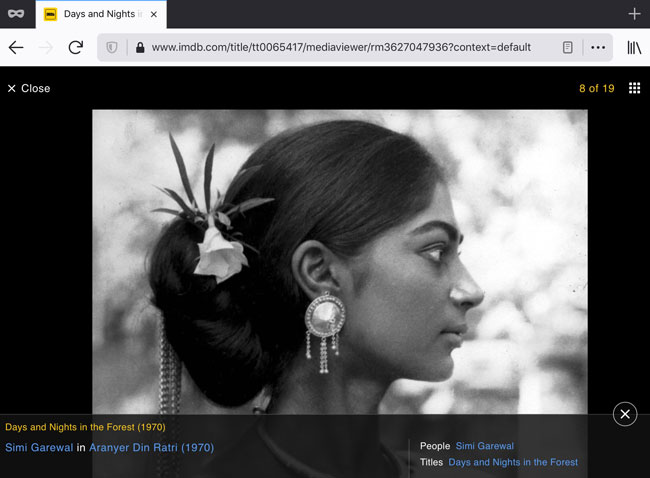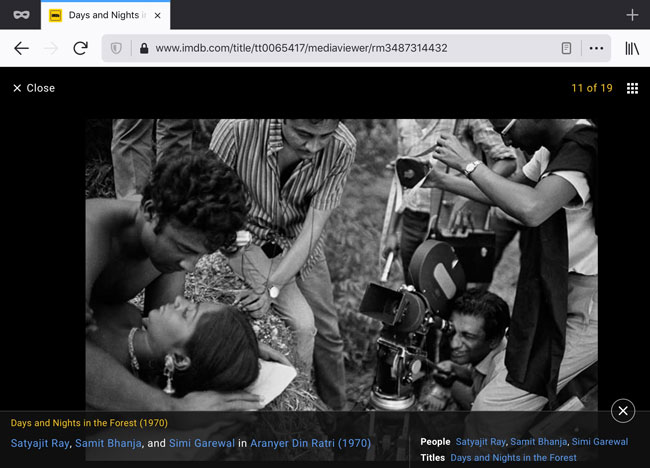
Aranyer Din Ratri (“Days and Nights in the Forest”)
For detailed information and more images visit satyajitray.org & IMDb >>
“The world sells humans. What kind of world is this?” – Hindi Movie “Kamla” revisited >>
The immediate impression of Indian movies is that all are depicting an established formula, where the good woman is usually vulnerable and innocent, mostly good looking and also helpless or lacking in intelligence. The bad woman is either sensuous or scary and wicked even in appearance. But Assamese cinema, especially as seen through most of the films taken for the study, has not stuck to this kind of stereotyping in the larger sense. Films in Assam, through the decades, have dealt with serious issues concerning the society, and women in majority of the films, rather than only showing romance and escapism.
Rashmi Sarmah, PhD thesis Assam titled “Gender Representation in the Cinema of Assam”, Assam University 2014, Abstract p. 11
URL: https://shodhganga.inflibnet.ac.in/bitstream/10603/55929/5/05_abstracts.pdf
Citation Details: https://shodhganga.inflibnet.ac.in/handle/10603/55929
Date visited: 1 November 2020
Research the above issues with the help of Shodhganga: A reservoir of theses from universities all over India, made available under Open Access >>
To discuss the underlying assumptions and stereotypes mainstream society projects onto Santal women, watch the relevant scene as part of the introduction by Preston Miller >>
Days and Nights in the Forest was one of Ray’s most successful films [wherein he introduces] an overt sensuality to his work. […] Feel the tension in this scene [5:10] A beguiling Santal woman [portrayed by a non-Santali actress Simi Garewal] whom [the young men in this story] met is hired to clean their room – and perhaps more. […] No girlfriend of these guys would be allowed to parade themselves in this manner […] In the forest, their true selves are revealed.
Source: Days and Nights in the Forest – introduction by Preston Miller
URL: https://youtu.be/lV8clWi_Vf0?t=4m54s
Date visited: 1 November 2020

Simi Garewal as “Duli the tribal servant” in Aranyer Din Ratri (“Days and Nights in the Forest”); going by the Summary on satyajitray.org the fact that it came to be regarded as “one of Ray’s most successful films” may, in part, be explainable by its portrayal of young men “full of the over-confidence of the big city and scant respect for the villagers” indulging in “drunken sprees and adventures with servants” who (spoiler alert) “depart again for the city, each with a better appreciation of life“.
For detailed information visit satyajitray.org & IMDb >>
The entire film by Satyajith Ray is available on YouTube:
Published on Aug 17, 2014
Directed by Satyajit Ray, 1970
Soumitra Chatterjee, Rabi Ghosh, Sharmila Tagore, Subhendu Chatterjee, Samit Bhanja, Pahari Sanyal, Kaberi Bose, Simi Garewal, Aparna Sen
Source: 
Address : https://www.youtube.com/watch?v=Uu–1QfYKHc&feature=youtu.be
Date Visited: Tue Sep 09 2014 20:58:52 GMT+0200 (CEST)
DAYS AND NIGHTS IN THE FOREST, REVISITED BY SUVRO ROY
Calcutta, Feb. 20: Ashim (an ex-political activist), Sanjay (typical middle-class Calcutta) and Hari (a sportsman) decide to go into a forest for a holiday. That’s what they had done, exactly 33 years ago. Unlike then, this time they are accompanied by their wives and children. They miss Shekhar, their fun-loving friend. Same place, same people (well, almost), different time…
Three decades after Aranyer Din Ratri took audiences by storm, there is a twist in the forest tale. In what marks a first in the history of Indian cinema, one of the leading directors of modern times is taking off from where the master of another era shut his camera-box. The result: A yet-to-be-named venture directed by Goutam Ghosh, which carries forward Satyajit Ray’s Aranyer Din Ratri.
The idea is simple: Ghosh is going to take up the characters immortalised by the Ray masterpiece. […]
Now, the three friends are all married, with children. Ashim and Aparna are back, having first met in the forests of Palamau and then going on to get married. But some faces are lost forever. What hurts most, says the director, is the absence of ‘Shekhar (Robida)’. Also missing from Ghosh’s scheme of things is the smouldering presence of Duli (Simi Garewal), the Santhal girl. All externals, from “the forest to the political situation to the social matrix”, have also changed.
“When I was making a documentary on Manikda, I saw Aranyer Din Ratri after a long time… I thought it would be interesting to take the characters back to the forest. But mind you, it’s not a sequel,” says Ghosh. “Sunilda’s (Gangopadhyay) novel was also a source of inspiration.” The actors are “most excited” at the prospect. “It is something like Yarrow Revisited. We are all looking forward to a return to the forest,” said Subhendu.
Source: http://www.telegraphindia.com/1020221/the_east.htm
Date Visited: Tue Sep 09 2014 20:37:06 GMT+0200 (CEST)
Listen to Incarnations: India in 50 Lives on BBC Radio 4 (22 March 2016) >>
Satyajit Ray: India without Elephants
Sunil Khilnani explores the life and work of filmmaker Satyajit Ray.
In the history of Indian cinema, there is a Before Ray, and an After. As Sunil Khilnani says, “he’s the first truly modern filmmaker we have.” But Satyajit Ray’s career in India might not have continued past its first few films had he not been celebrated in the West.
In his native Bengal, several of his films were popular. More were loathed. In today’s thriving Bengali film culture, he’s often held at arm’s length: the guy who served it up for the West, and served it up a little sweet.
But Ray’s films made ideas hanging in the air feel fresh, for he brought to them an unusually large range of small gifts: psychological and sensory acuity, humour, humanism, a deep appreciation of family relationships, an ability to withhold judgement, an ear equally adept at dialogue and sound, and the visual imagination of a third-generation illustrator and photographer. These were sufficient to allow him, time and again, to achieve a realism few in Indian cinema wanted to meet.
“It’s the truth in a situation that attracts me,” he told his actors. “And if I’ve been able to show it, that’s enough for me.”
The result was a body of work of which the director Akira Kurosawa would remark, “Not to have seen the cinema of Ray means existing in the world without seeing the sun or the moon.”
Source: Incarnations: India in 50 Lives on BBC Radio 4
URL: https://www.bbc.co.uk/programmes/b07428by
Date Visited: 14 June 2021
It seems that there are all kinds of unresolved problems to do with Satyajit Ray – to do with thinking about him, with finding a language to speak about him that does not repeat the indubitable truisms about his humanism and lyricism. How does he fit into history, and into which history – the history of India; the history of filmmaking; some other – do we place him first? […]
His humanism was noted in his heyday, but the encounter with Indian modernity that watching his films constituted was hardly mentioned.
To me [Amit Chaudhuri], it is increasingly clear – especially in the light of the changes in politics and culture in the last quarter of a century – that Ray is the only embodiment of an Indian “high” modernity, specifically a vernacular “high” modernity, that the world has had to deal with. […]
Ray points out that “a slow pace is, I believe, as legitimate to films as it is to music. But as a director, I know that a slow pace is terribly hard to sustain. When the failure is the director’s fault, he should be prepared to take the blame for it. But it is important to remember that slowness is a relative thing, depending on the degree of involvement of the viewer”.
With the phrase “a relative thing”, Ray is, I think, gently refuting the “universal” cultural situation presumed by Western critics, and arguing, somewhat diffidently, for his Easternness. But he does not remind us that slowness is also a principal, even sacred, feature of modernism, which privileges the image over the narrative, the individual moment over the overarching time-span, thus holding up the way a story ordinarily unfolds. […]
Source: “Amit Chaudhuri on Satyajit Ray’s very Indian modernity: Not a ‘beginning’ as much as a ‘fruition’”, Scroll, 28 December 2020
URL: https://scroll.in/reel/982459/amit-chaudhuri-on-satyajit-rays-very-indian-modernity-not-a-beginning-as-much-as-a-fruition
Date Visited: 14 June 2021
[Bold typeface added above for emphasis]
Learn more
- Customs
- Film
- Forest dwellers in early India – myths and ecology in historical perspective
- Social conventions
- Video | The Karbi Ramayana in Assam and its Modern Re-telling in Documentary Film

Learn more about this and other murals in West Bengal >>